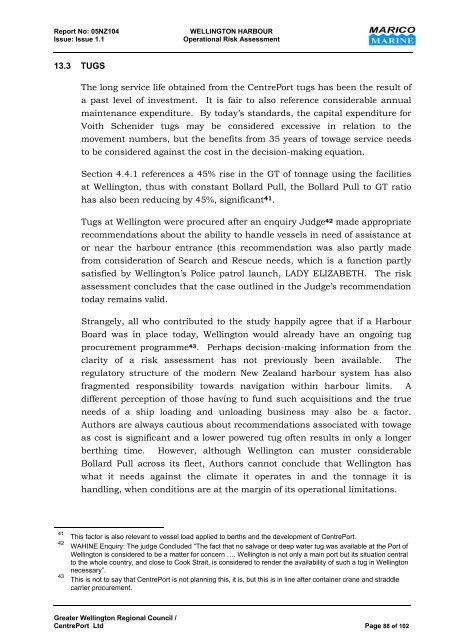MARICO Marine NZ Limited WELLINGTON HARBOUR PORT AND ...
MARICO Marine NZ Limited WELLINGTON HARBOUR PORT AND ...
MARICO Marine NZ Limited WELLINGTON HARBOUR PORT AND ...
Create successful ePaper yourself
Turn your PDF publications into a flip-book with our unique Google optimized e-Paper software.
Report No: 05<strong>NZ</strong>104 <strong>WELLINGTON</strong> <strong>HARBOUR</strong><br />
Issue: Issue 1.1 Operational Risk Assessment<br />
13.3 TUGS<br />
The long service life obtained from the CentrePort tugs has been the result of<br />
a past level of investment. It is fair to also reference considerable annual<br />
maintenance expenditure. By today’s standards, the capital expenditure for<br />
Voith Schenider tugs may be considered excessive in relation to the<br />
movement numbers, but the benefits from 35 years of towage service needs<br />
to be considered against the cost in the decision-making equation.<br />
Section 4.4.1 references a 45% rise in the GT of tonnage using the facilities<br />
at Wellington, thus with constant Bollard Pull, the Bollard Pull to GT ratio<br />
has also been reducing by 45%, significant41 .<br />
Tugs at Wellington were procured after an enquiry Judge42 made appropriate<br />
recommendations about the ability to handle vessels in need of assistance at<br />
or near the harbour entrance (this recommendation was also partly made<br />
from consideration of Search and Rescue needs, which is a function partly<br />
satisfied by Wellington’s Police patrol launch, LADY ELIZABETH. The risk<br />
assessment concludes that the case outlined in the Judge’s recommendation<br />
today remains valid.<br />
Strangely, all who contributed to the study happily agree that if a Harbour<br />
Board was in place today, Wellington would already have an ongoing tug<br />
procurement programme43. Perhaps decision-making information from the<br />
clarity of a risk assessment has not previously been available. The<br />
regulatory structure of the modern New Zealand harbour system has also<br />
fragmented responsibility towards navigation within harbour limits. A<br />
different perception of those having to fund such acquisitions and the true<br />
needs of a ship loading and unloading business may also be a factor.<br />
Authors are always cautious about recommendations associated with towage<br />
as cost is significant and a lower powered tug often results in only a longer<br />
berthing time. However, although Wellington can muster considerable<br />
Bollard Pull across its fleet, Authors cannot conclude that Wellington has<br />
what it needs against the climate it operates in and the tonnage it is<br />
handling, when conditions are at the margin of its operational limitations.<br />
41<br />
This factor is also relevant to vessel load applied to berths and the development of CentrePort.<br />
42<br />
WAHINE Enquiry: The judge Concluded “The fact that no salvage or deep water tug was available at the Port of<br />
Wellington is considered to be a matter for concern …. Wellington is not only a main port but its situation central<br />
to the whole country, and close to Cook Strait, is considered to render the availability of such a tug in Wellington<br />
necessary”.<br />
43<br />
This is not to say that CentrePort is not planning this, it is, but this is in line after container crane and straddle<br />
carrier procurement.<br />
Greater Wellington Regional Council /<br />
CentrePort Ltd Page 88 of 102
















